Seize the Albany Opportunity to Do More for NYCHA
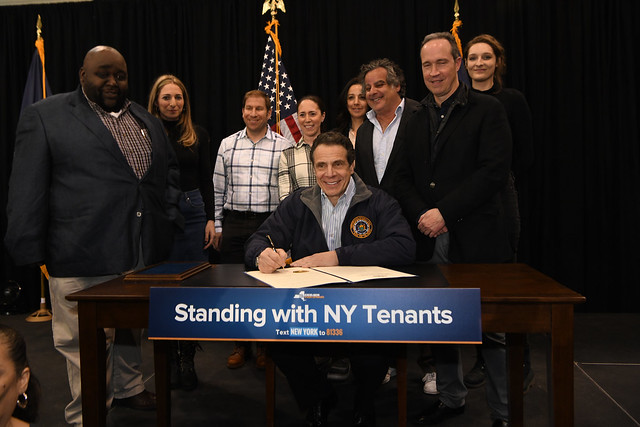
Danny Barber, left, is the author; with Gov. Cuomo & others (photo: the Governor's office)
I stood with Governor Cuomo last year when he showed how bad conditions in public housing have gotten after decades of federal neglect. With the governor’s leadership, NYCHA was allocated $250 million in last year’s state budget. While that money was held up due to the appointment of a federal monitor, the need for additional funds remains again this year.
Major capital repairs are needed to keep residents safe and healthy in all five boroughs. Leaks, mold, pests, broken elevators, and lead are a constant worry for us 400,0000 public housing residents as we try to get to work or school or care for our families at home.
The Assembly called for $300 million and the Senate asked for $250 million in the annual state budget process earlier this year. So far, NYCHA has gotten zero. This surprises me given the governor’s commitment and the tumultuous year NYCHA has had, leaving residents with great uncertainty about the future status of our homes.
State lawmakers have a chance to redeem themselves and commit to fighting to preserve NYCHA by appropriating capital funds before the end of this year’s legislative session, which is scheduled to finish this week and is expected to include decisions on capital allocations.
Albany also has an opportunity to create a more just and equitable tax policy while funding public housing, and it won’t cost a dime in state budget money.
This year, New York City will give away about $600 million to homeowners through the Cooperative and Condominium Property Tax Abatement, which reduces real property taxes for owner-occupiers by 17.5% to 28.1%, depending on assessed value. With the abatement scheduled to sunset this week, Albany lawmakers have an opportunity to provide a long-term funding solution for public housing.
Reform legislation has been introduced in the Assembly by Robert Rodriguez with a companion bill in the Senate sponsored by the housing committee chair Senator Brian Kavanagh. This bill preserves the tax abatement for 90% of homeowners, while eliminating tax breaks for the top 10% of luxury coops and condos.
By ending this tax break for the top 10% of luxury owners now, $170 million in tax revenue will be collected each year. The reform legislation earmarks this revenue for capital repairs in public housing, which can help bring NYCHA into compliance with federal regulations protecting tenants from health hazards such as mold, lead, and vermin.
More than 320,000 cooperative and condominium homeowners received an average tax break of $1,890 in fiscal year 2019 but benefits to luxury homeowners far exceed this average. President Trump, for example, was eligible for $48,000 in tax relief when he resided in Trump Tower. This reform bill will end tax breaks for luxury owners who don’t need them. New York City’s Housing and Vacancy Survey indicates that 10% of all coop and condo owners citywide earn more than $350,000 per year. That number contrasts sharply with $24,000, the average income for residents in public housing.
Albany lawmakers will have to decide if they want to renew the current abatement and perpetuate housing inequality or if they want to reform it by ending tax breaks to luxury properties and fund repairs that will benefit many thousands of public housing residents. The choice seems simple.
***
Danny Barber is Chair of the Citywide Council of Presidents of NYCHA residents, representing 400,000 public housing residents. He is also President of Jackson Houses Resident Inc., Chairman of the South Bronx District Council of Presidents Inc., and a member of Community Board 1.
***
Have an op-ed idea or submission for Gotham Gazette? Email This email address is being protected from spambots. You need JavaScript enabled to view it.
For the Earth's Sake, Enforce Bus Lanes with Cameras
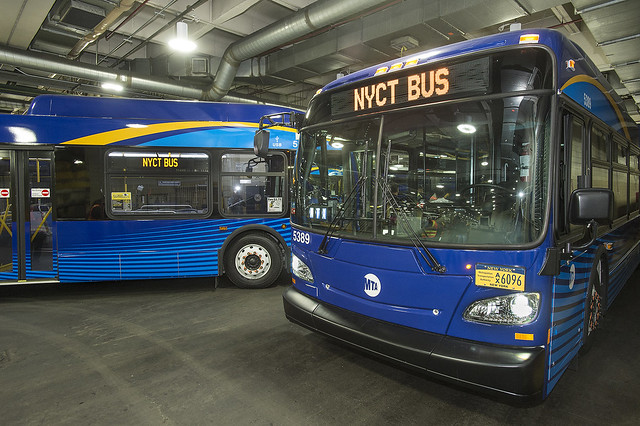
(photo: MTA/Patrick Cashin)
Transit policy is climate policy. In New York, transportation emits 30% of the city’s carbon pollution and 34% of the state’s. Since it’s easier to drive less in a city than in suburban and rural areas, much of that is carbon we can easily spare. When shrinking New York’s carbon footprint, transportation emissions are low-hanging fruit.
Granted, the challenge is stiff. Car registrations in the city are rising, up 9% in the past four years. The city’s own government vehicle fleet has grown 19% in size and 25% in miles traveled in the past five years. City agencies hand out an estimated 150,000 placards that privilege public employees to park their personal cars on our streets, encouraging them to drive rather than ride transit.
Car culture is resilient throughout the city. In many communities, a car is a status symbol. Many immigrants, low-income New Yorkers, and New Yorkers of color drive for a living. Taxi drivers protested the recent enactment of congestion pricing. Even progressives in Greenwich Village and Chelsea objected to shuttle bus service for L train riders displaced by construction.
To their credit, our leaders have made major commitments to transit. Governor Cuomo and the Legislature passed congestion pricing to fund major subway upgrades. Both Mayor de Blasio and the MTA made historic promises and have begun to improve bus service. City Council Speaker Corey Johnson successfully championed reduced transit fares for low-income riders in the city budget and made a public pledge to “break the car culture.” Comptroller Scott Stringer has produced game-changing reports on bus service and commuter rail.
But there’s a lot more to do. Shifting decisively away from cars and toward transit will require major policy change. If done right, it will make the city more equitable, enhance the quality of life for millions of New Yorkers, and help save everyone on the planet from out-of-control climate change.
First, it’s crucial that the governor fully implement congestion pricing. Congestion pricing has the potential to directly cut citywide carbon emissions by nearly one million tons annually. By cutting congestion, congestion pricing will also indirectly cut emissions even further by making it easier for families and businesses to locate or stay in the city rather than leave for more carbon-intensive lifestyles in the suburbs or beyond.
Second, congestion pricing revenue must be dedicated to fixing the subway. Despite recent improvements in performance, our subway system remains in crisis. While jobs, population, and tourism numbers hit record highs, our subways have been losing riders for three years running, a longer decline than any since the fiscal crisis of the 1970s. The system desperately needs modern signals, new subway cars, and elevators that will provide access to New Yorkers with disabilities.
Third, the city and the MTA must deliver on the promise of better bus service in every neighborhood. Today, our buses are the slowest in the nation, mired in traffic, and bogged down with countless stops along convoluted routes. Bus ridership has been falling for over a decade, along with average speeds.
The mayor needs to build out a robust bus lane network in tandem with the MTA’s redesign of each borough’s bus map. Truly turning bus service and ridership around will require prioritizing buses and riders along crowded commercial streets. It will also mean changing the spacing of bus stops so that buses can get up to speed and keep moving, delivering faster and more reliable service. Properly spaced bus stops should be upgraded with amenities like shelters, benches, legible maps, and countdown clocks.
These commitments will take years to be achieved. Meanwhile, there’s one transit policy item on this session’s Albany legislative agenda that can make a real difference, really soon. Assemblymember Nily Rozic and Senator Liz Krueger are sponsoring legislation (A6777/S1925) that would reauthorize and expand the bus lane camera program citywide.
Dedicated lanes are essential to quality bus service but are only as good as they are enforced.
To effectively prioritize bus riders on busy city streets, bus lanes must be kept clear of obstructions. The NYPD has only so many officers and myriad other responsibilities. Enforcement cameras nudge drivers to steer clear and leave bus lanes to bus riders.
Curbing climate change requires a broad range of policy tools. Many of them involve better transit. Before the end of the session this month, the state Legislature and governor have an important opportunity to put bus riders and the climate first. They should take it.
***
Danny Pearlstein is Policy and Communications Director of the Riders Alliance. On Twitter @RidersNY.
***
Have an op-ed idea or submission for Gotham Gazette? Email This email address is being protected from spambots. You need JavaScript enabled to view it.
The MTA is Fiscally Exhausted
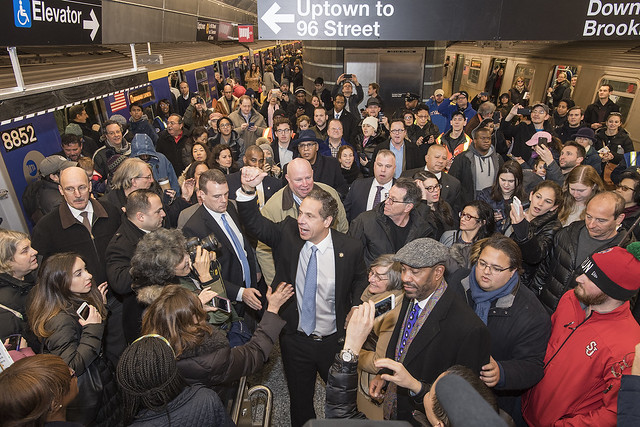
(photo: MTA/Patrick Cashin)
We call it the distraction circus. Donald Trump’s advisor, Steve Bannon, called it “flooding the zone with sh*t” to befuddle the news media and critics. Whatever you call it, the endless kerfuffle Governor Cuomo is stirring around the Metropolitan Transportation Authority (MTA) is obscuring what we think are the MTA’s potentially catastrophic money problems.
Yes, even after new revenue from congestion pricing is factored in, the MTA is still in big financial trouble.
Five very big things jump out in terms of the MTA’s fiscal health. First, Governor Cuomo and legislative leaders are sending strong signals they are going to renege on the remaining $7.3 billion they promised the MTA in direct state aid in the 2016 state budget for the 2015-2019 MTA capital plan. Second, the governor says state monies will generate only about $30 billion of the $40 billion to $60 billion his own workgroup estimated the MTA needs for its 2020-2024 capital plan.
Third, the governor is strongly suggesting the MTA will have to borrow roughly $10 billion to $30 billion on top of its already soaring debt load. Fourth, even with massive cost cutting, the MTA’s debt payments are rising to alarming levels, with 19% of operating income possibly going to debt by 2022, raising the harbinger of a “death spiral.”
Fifth, these are not the MTA issues the Board, Legislature, or transit reporters are talking about nearly enough.
Importantly, the MTA is facing these dire fiscal pressures while New York City’s economy is in the midst of a decade-long boom and state and city tax revenues are at record levels. What happens when there is the inevitable downturn?
The MTA is Fiscally Exhausted, so Where is the $7.3B?
With much fanfare, the Governor and State Legislature included in the 2016 state budget a “historic” commitment of $8.3 billion in direct state aid to the MTA’s 2015-2019 capital plan. More than three years later, the state still owes the MTA $7.3 billion.
The devil is truly in the details for state budget promises. The much touted 2016 state bailout of the MTA allowed $1 billion to be given to the MTA without condition, but an additional $7.3 billion will only be available after the MTA borrows until it can borrow no more -- in other words, when the MTA is fiscally “exhausted.” (See Part NN of the 2016 budget.)
As of May 2019, the MTA has gotten only $1 billion of the state bailout money promised in 2016, and $11 billion from all sources for the $33 billion it planned to spend on the 2015-2019 capital plan.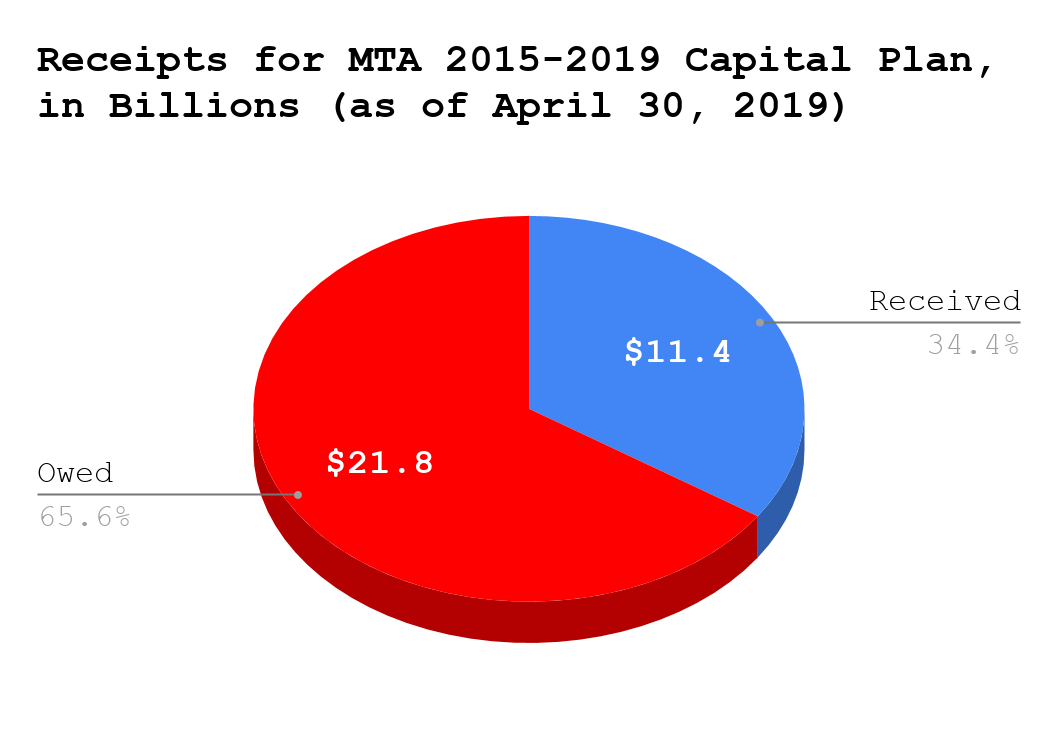
The Subway Action Plan: A Distraction from the $7.3B owed by the State?
As of December 2017, the MTA had received only $65 million of the state capital dollars promised in the April 2016 state budget for its 2015-2019 capital plan. In July 2017, the governor announced the Subway Action Plan, which included $328 million for capital projects (which is less than 5% of the $7.3 billion of the promised state capital funds). Yet, the Subway Action Plan has become a proxy for effort by the state. The governor’s office has repeatedly emphasized the millions the state was contributing to the Subway Action Plan while glossing over the $7.3 billion it owes the MTA.
[READ: There's Plenty of Money in the MTA Capital Plan, It's Just Not Being Spent]
MTA Tens of Billions Short of Funding Needed for Capital Plan Starting in 2020
To recap, the state still owes the MTA $7.3 billion for the current, 2015-2019 capital plan. Now, the governor says the MTA won’t get new state funding for the next capital plan.
Last week, Governor Cuomo doubled down on his rhetoric that the MTA must “reform” or it won’t get more funding from the state for the MTA’s 2020-2024 capital plan. Speaking on The Brian Lehrer Show, the governor said that the MTA will get only $30 billion from the state for the MTA 2020-2024 capital plan, including congestion pricing and state dedicated taxes, saying it needs to do better with the billions it has. This is much less than the $40 billion to $60 billion Cuomo’s own MTA Sustainability Workgroup concluded in December 2018 would be needed for the 2020-2024 plan.
The biggest problem with this statement is that the MTA is already fiscally exhausted, and “reform” -- including possible consolidations from a forthcoming reorganization plan (more on that here) -- will not possibly make up the additional $10 to $30 billion that the MTA is missing to meet its needs for the next capital plan.
Skyrocketing Debt Payments: 19 Cents of Every Fare Dollar
While the MTA has been borrowing itself into a state of “fiscal exhaustion” to meet the terms of the 2016 state budget for its promised $7.3B, debt service payments have soared to record levels.
In 2017, debt payments cost 17% of the MTA’s operating budget. By 2o22, debt payments will consume 19% of the operating budget, as projected in its February 2019 financial plan. (All charts in this piece are sourced from data in this plan.)
In total, debt payments will be $3.22 billion in 2022 -- an increase of 27% since 2017.

And with a threat from the governor of no more state funding, the MTA seems to be on the path toward even more borrowing if it is to even attempt to meet its capital needs for 2020-2024.
Blunt Cuts Won’t Save the MTA
With debt service on the rise and ridership declining, the MTA is facing a large operating deficit. The operating budget pays for everyday subway, bus, and rail service, and money borrowed to pay for capital expenses. Every dollar paying back borrowed money is a dollar that cannot be spent on subway or bus service.
As debt costs soar, so does the ongoing gap between the MTA’s income and expenses. The MTA’s deficit for 2020 has now reached $467 million, with even larger gaps in the years to come. (To be sure, the MTA is also struggling with costs including health care for current and retired workers -- a problem for many big employers in the U.S.)
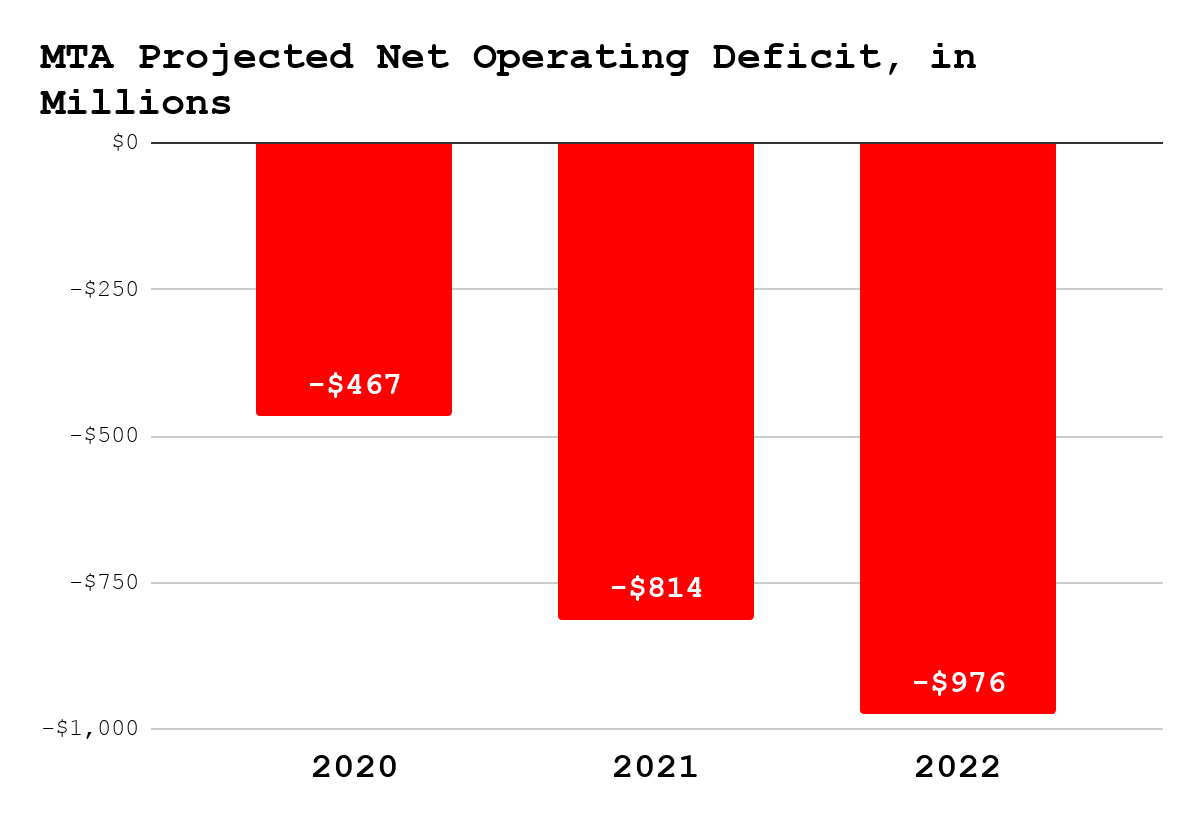
If the MTA can’t reduce its debt payments, how can it make up future operating losses? The biggest likelihood is through workforce reductions, which could increase the risk of entering a “death spiral” of less service, fewer riders, and less farebox revenue. Labor makes up 60% of operating costs and the MTA’s labor contracts are up for renewal this year. The MTA has 75,000 employees and is by far the largest unit of state government.
There are rumors of big layoffs circulating within the MTA. The obvious concern for riders is how layoffs affect customer service. A smart reorganization of the MTA could make sensible consolidations, but there is tremendous pressure to close the MTA’s operating deficit and chop out dead wood. The risk is the reorganization could decimate the MTA’s workforce at a time when working for the MTA is not likely at the top of job seekers’ lists, all while the governor continues to harshly criticize the MTA professional staff for lack of innovation and execution.
Exhausted and in Danger
In the 2016 budget, the governor and Legislature committed $8.3 billion to the MTA. They have given it $1 billion. Will the MTA get the remaining $7.3 billion? Will the governor and Legislative Leaders finally level with the public? Where the heck is the MTA supposed to find the roughly $50 billion it needs for the 2020-2024 rebuilding plan? How much money does the MTA really need? What is the debt redline? Some states keep debt payments at 5% to 7% of their operating budgets, while the MTA is edging towards an astronomical 19%. The danger signs for the MTA are mounting, and we need an honest discussion of how to fix this problem before it’s too late.
[READ: There's Plenty of Money in the MTA Capital Plan, It's Just Not Being Spent]
***
Rachael Fauss is Senior Research Analyst and John Kaehny is Executive Director at Reinvent Albany. On Twitter @ReinventAlbany.
***
Have an op-ed idea or submission for Gotham Gazette? Email This email address is being protected from spambots. You need JavaScript enabled to view it.




